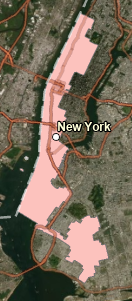Lab 4 [GIS5103]: Geoprocessing
The screenshot above provides the output from a Python script created this week to process a shapefile containing the locations of hospitals around the University of Texas at Austin, as shown here for part of this map:
A 1000-meter buffer was created around each hospital location, and then these overlapping buffer regions were dissolved into a separate, single feature, as shown here for the final output around the same area shown above:
An overview of the major steps in the overall workflow is provided here:
Overview of Major Steps in Overall Workflow:
STEP
0: verify licensing,
extensions, and input file hospitals.shp
available
STEP
1: hospitals.shp à add XY coordinates à produce hospitalsXY.shp
STEP
2: hospitalsXY.shp à perform buffering à produce hospitalsXY_buffered.shp
STEP
3: hospitalsXY_buffered.shp à perform dissolving à produce hospitalsXY_buffered_dissolved.shp
Key ArcPy functions explored this week for error handling included the following:
- arcpy.ProductInfo() – used to confirm current product license
- arcpy.CheckExtension() – used to confirm Spatial Analyst extension available
- arcpy.Exists() – used to confirm that the input shapefile (hospitals.shp) was available
Finally, the ArcPy function sys.exit() was also explored this week as a means to terminate the program if the necessary license, extension, and input file were not available at the start of the script.






Comments
Post a Comment